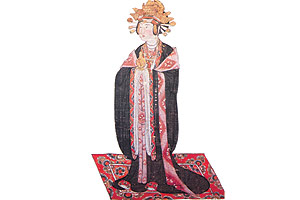Han Dynasty emperors (207-220 A.D. aprox) imposed Confucianism and created a network of highly trustworthy officials, called «mandarins». They kept the Chi’n administrative structure but suppressed its authoritarian features. Han China expanded its boundaries, incorporating modern day Tibet, North Korea and a part of Vietnam. Intensive trade was carried out with northern neighbors, as well as with Europe, through the «Silk Road». Education and sciences flourished. Simultaneously, Buddhism (a philosophical and religious system based on Buda’s teaching) was introduced into China from India.
Finally, the revolts of northern peoples quickened the decline of this Dynasty (around 220 A.D.) and the beginning of a new era began, called the Three Kingdom Period (221-256 A.D.). This was followed by a proliferation of states: the «Twenty Northern Kingdoms» and the «Six Dynasties of the South» (220-586 A.C.). During this last period and due to attacks from nomads, there was a great migration towards the south, which brought with it the diffusion of Buddhism and Taoism. Finally, the north imposed itself on the south and the Sui Dynasty (589-618 A.D.), which reunited China, started.
The empire flourishes
The Sui, however, soon collapsed. This is attributed to a popular uprising against the obligations the government imposed: heavy taxes and work levies in reconstruction and termination works on the Grand Canal and the Great Wall, respectively.
So the Tang or T’ang succeeded the Sui (618-907 A.D.) and opened one of the brightest periods in Chinese history, both in the cultural and in the economic fields.
This dynasty persevered on the unifying policy undertaken by the Sui. They reorganized the adminstration and approved laws favorable to the people’s well being. Militarily, the Turks and Koreans were defeated. Expansionism favored trade, which multiplied during this period, thus fostering the internal development of the extractive industry and metallurgy.
The arts developed under the patronage of the imperial court. Poetry flourished as it had never done before. Cultural exchange with other nations fructified: from Korea and Japan, monks and students traveled to China fascinated by the greatness of the empire. In China, scientists took advantage of these contacts to improve their own knowledge.
New internal rebellions, however, ended the Tang Dynasty (907 A.D.). A period of wars and disorder ensued that lasted 50 years (907-960 A.D.), known as the «The Five Dynasties and Ten Kingdoms Period».
In 960, the Song Dynasty reunited the country and carried out a series of reforms that stimulated trade, which is said to have become so intense that statues were melted to make coins. Nevertheless, the Songs lost control of the North and were expelled. They moved their capital to Hangzhou, where the arts and literature flourished. This state of affairs lasted until the Mongols, led by Genghis Khan began invading China.
In 1279, Genghis Khan’s grandson, Kublai (or Khubilai) Khan brought the conquest of China to a completion and proclaimed himself Emperor of China. He made Khanbaliq (later to become Beijing) his capital. The Yuan Dynasty had thus begun (1279-1368).
This dynasty designed an ethnically stratified society. On the top were the Mongols, followed by the other allies from the Steppe; then came the northern Chinese people and finally the southern Chinese people. This generated resentment against the foreign dynasty, which manifested later in numerous rebellions.
Despite this, the Yuan managed to develop metallurgy, could manufacture weapons and their workshops specialized in wood, jade and glass.
During their reign, they repaired and extended the Grand Canal To facilitate communications, and the arts and sciences achieved relative splendor.
It was during the Yuan Dynasty that the first travelers coming from the West, Marco Polo and Ibn Batuta (see inbox), arrived to China.
Popular revolts incremented as of 1325 due to the deteriorating conditions the peasants were living in. This, added to a increasing decline in Mongol military strength, ended in the rebellion led by Buddhist monk Zhu Yuanzhang, who instaurated a new dynasty, the Ming Dynasty (1368-1644 A.D.).








 Muere Evita
Muere Evita